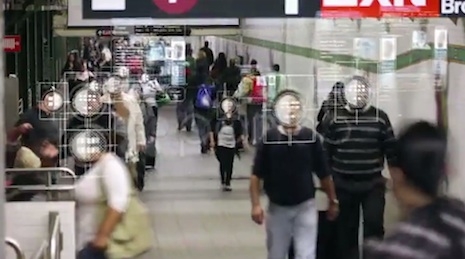
As with so much else, William Gibson got there before just about everyone else. In his 1984 novel Neuromancer, which despite its deservedly huge rep probably still doesn’t get name-checked as often as it should, Gibson foresaw the utility of citizen camouflage, the political necessity to stay anonymous, to hide in plain sight. Here are a couple of quotations from Neuromancer:
The Panther Modern leader, who introduced himself as Lupus Yonderboy, wore a polycarbon suit with a recording feature that allowed him to replay backgrounds at will. Perched on the edge of Case’s worktable like some sort of state of the art gargoyle, he regarded Case and Armitage with hooded eyes.
-snip-
The precis began with a long hold on a color still that Case at first assumed was a collage of some kind, a boy’s face snipped from another image and glued to a photograph of a paint-scrawled wall. Dark eyes, epicanthic folds obviously the result of surgery, an angry dusting of acne across pale narrow cheeks. The Hosaka released the freeze; the boy moved, flowing with the sinister grace of a mime pretending to be a jungle predator. His body was nearly invisible, an abstract pattern approximating the scribbled brickwork sliding smoothly across his tight one piece. Mimetic polycarbon.
Those things were written thirty years ago. It’s now 2014, and we’ve all seen Facebook find the faces in our pictures with alarming alacrity.
Leo Selvaggio wants to do something about it, and he wants to use the logic of crowdsourcing to do it. Using 3D printing technology, Selvaggio has developed a simple, hard resin mask based on his own face, and he would like as many people as possible to use it in public settings, to confound the cameras that are always watching us and tracking our movements. It’s called the URME Personal Surveillance Identity Prosthetic. The mask is an abstraction, but a highly effective one. If you saw someone with this face on the street, you wouldn’t stop to take notice—which is part of the point. It faithfully reproduces Selvaggio’s own pasty skin tone and understated stubble in a way that blends in. The mask costs $200 but you can also procure a paper version if that is too pricey for you. The whole idea is radical enough that some countries have anti-mask laws.

You aren’t the only who benefits when you wear an URME mask in public—you’re also helping Leo himself hide. “What is actually happening is that you’re creating disinformation,” he says. “What happens when there’s a hundred Leos walking in public spaces, all from different parts of the country? What is an automated system going to say about me then?” But it doesn’t—can’t—stop with Leo’s face. Responding to a questioner who volunteered to be his “black face” on the video for his Indiegogo project (see below), which was successfully funded, Leo wrote back, “Actually the next phase of the project involves asking others to donate their faces so that there is a variety of prosthetics and masks available.”
Selvaggio hails from Chicago, which he asserts is “the most surveilled city” in the U.S.—it’s home to Operational Virtual Field, a system of 24,000 cameras all networked into a single hub that enables users—the police—to find a specific individual and then bring up any other relevant records in the system. The ACLU has called Operation Virtual Field, “a pervasive and unregulated threat to our privacy,” even as Richard M. Daley, Chicago’s last mayor, gleefully predicted that by 2016, there will be a camera on “almost every block.”
As always, it’s virtually impossible to navigate the Scylla of the right to privacy and autonomy and the Charybdis of public safety. Will the URME mask enable bank robbers and bombers of the Boston Marathon type to do their business? Will the teenagers who tagged your local high school use it to perpetrate their harmless mayhem? Very likely, yes. We’re all worried about that. But the flip side is, do we let the authorities monitor our every movement at all times? Do we do so without weighing in on the process?





